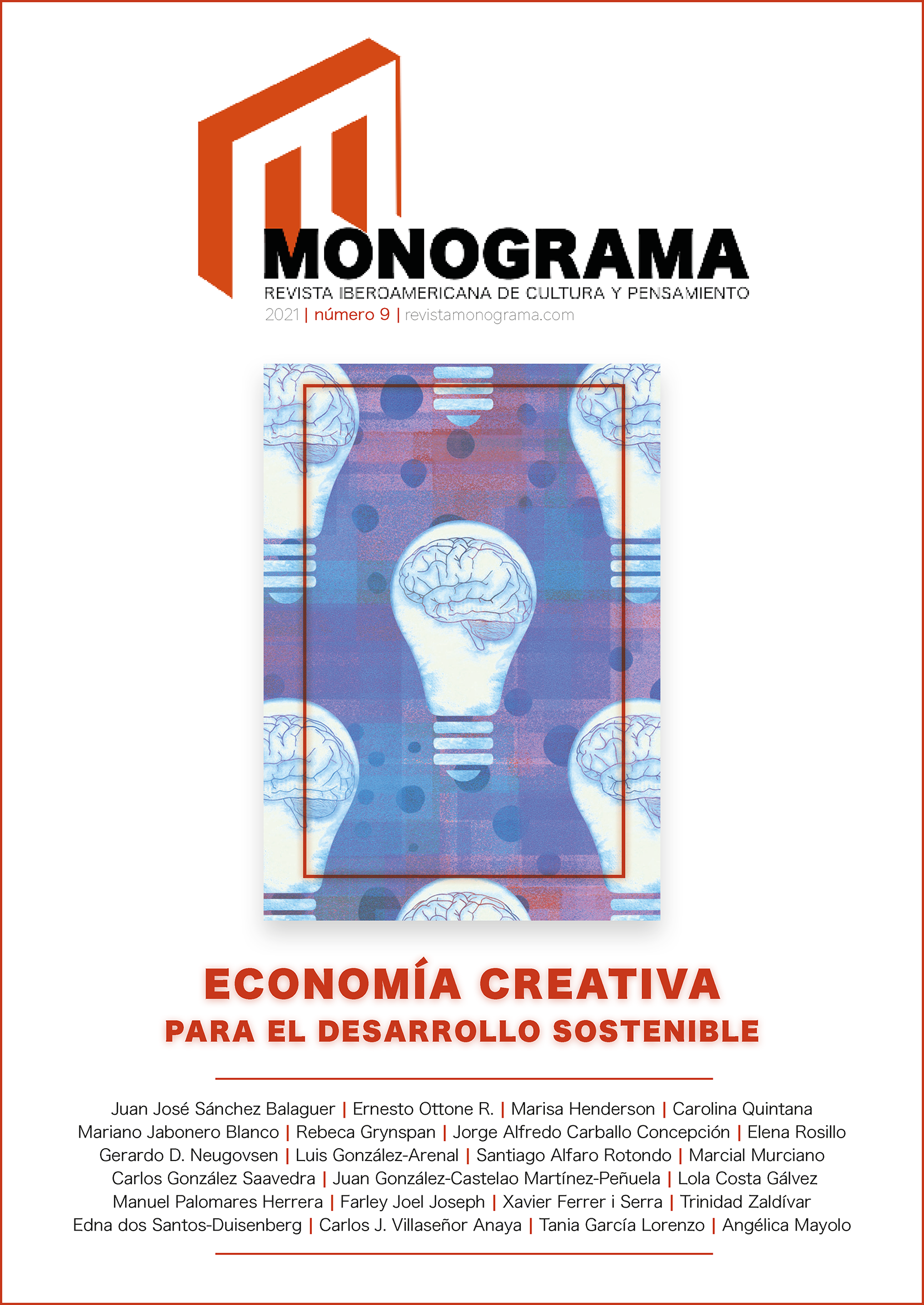Industrias creativas y culturales en España: efectos de la COVID‑19 sobre la economía y el empleo cultural
DOI:
https://doi.org/10.36008/monograma.2021.09.2118Palabras clave:
ICC, COVID-19, ICC en España, métricas culturales, ICC y comunidades autónomas, empleo cultural, política cultural, sistema cultural, EspañaResumen
La interrupción generalizada en España de las actividades culturales debido a la pandemia de la COVID‑19 ha incidido negativamente en la economía del sector y provocado la pérdida de gran número de puestos de trabajo. En el presente artículo se analiza, a partir de los datos oficiales disponibles, el comportamiento del empleo cultural y creativo en España durante el año 2020, en comparación con los precedentes. Se ha aplicado una metodología mixta basada en el estudio de métricas homologadas en el campo y en los documentos cualitativos de la instituciones europeas y multilaterales señaladas en la bibliografía. La fuente principal de documentación es la explotación estadística de la Encuesta de población activa para el ámbito cultural del Ministerio de Cultura y Deportes, basada en los datos del Instituto Nacional de Estadística (Ministerio de Cultura y Deporte e INE, 2021), aunque también se emplean magnitudes obtenidas en registros administrativos como las afiliaciones a la Seguridad Social. Las métricas disponibles sobre las Industrias Creativas y Culturales (ICC) confirman un notable retroceso de la actividad económica y del empleo cultural en España, por ocupaciones, género, grupos de edad, nivel de estudios y Comunidades Autónomas, que ponen en evidencia la necesidad política de revitalizar y considerar nuevas formas de experiencia cultural y de difusión de modelos de negocio que reequilibren la economía y la ocupación de este sector estratégico.
Descargas
Citas
Anderson, C. (2007). La economía Long Tail: de los mercados de masas al triunfo de lo minoritorio. Barcelona: Tendencias.
Bourlès, L. y Nicolas, Y. (2021). Analyse conjoncturelle du chiffre d’affaires de la culture au 4e trimestre 2020. París: Ministère de la Culture.
Comisión Europea (26 de abril de 2021). Creative Europe. Obtenido de Coronavirus: How it Affects the Creative Europe Programme. Disponible en: https://ec.europa.eu/culture/resources/coronavirus-response/coronavirus-how-it-affects-creative-europe-programme.
Comisión Europea (2019). Impulse paper on the role of cultural and creative sectors in innovating European industry. Luxemburgo: Publications Office of the European Union.
Convenio Andrés Bello (2009). Cuenta satélite de cultura. Manual metodológico para su implementación en Latinoamérica. Bogotá: Convenio Andrés Bello.
De Domingo Sanz, M. V. (2011). El empleo y el paro: comparación de los resultados de la EPA con los de fuentes administrativas. Madrid: Instituto Nacional de Estadística.
Department of Communications and the Arts (1994). Creative Nation: Commonwealth Cultural Policy. Camberra: Department of Communication and the Arts.
Department of Culture, Media and Sport (1998). Creative Industries Mapping Document. Londres: Department of Culture, Media and Sport.
European Institute of Innovation and Technology (22 de abril de 2021). European Institute of Innovation and Technology (EIT). Disponible en: 2021 Call for Proposals: https://eit.europa.eu/our-activities/call-for-eit-communities/2021.
Eurostat (16 de abril de 2021). Culture statistics-cultural employment. Disponible en Cultural employment, 2019: https://ec.europa.eu/eurostat/statistics-explained/index.php?title=Culture_statistics_-_cultural_employment.
GESAC-Ernst & Young (2021). Rebuilding Europe: The cultural and creative economy before and after the COVID-19 crisis. París: The European Grouping of Societies of Authors and Composers.
Heather, C., O’Brien, D. y Gable, O. (2021). Screened out. Tackling class unequality int he UK Screen Industries. Londres: Creative Industries Policy and Evidence Centre.
Instituto Nacional de Estadística (26 de abril de 2021). INE. Disponible en: Encuesta de Población Activa, Metodología 2005: Descripción general de la encuesta: https://www.ine.es/inebaseDYN/epa30308/docs/resumetepa.pdf.
Jefatura del Estado (5 de mayo de 2020a). Real Decreto-ley 17/2020, de 5 de mayo, por el que se aprueban medidas de apoyo al sector cultural y de carácter tributario para hacer frente al impacto económico y social del COVID-2019. Boletín Oficial del Estado , pp. 31291-31319.
Jefatura del Estado (4 de noviembre de 2020b). Real Decreto-ley 32/2020, de 3 de noviembre, por el que se aprueban medidas sociales complementarias para la protección por desempleo y de apoyo al sector cultural. Boletín Oficial del Estado (291), págs. 95808-95819.
Merino Llorente, M. C., Somarriba Arechavala, N. y Negro Macho, A. M. (2012). Un análisis dinámico de la calidad del trabajo en España. Los efectos de la crisis económica. Estudios de Economía Aplicada, 30(1), pp. 261-282.
Ministerio de Cultura y Deporte e INE (16 de abril de 2021). CULTURABase. Disponible en: Empleo Cultural. Explotación de la Encuesta de Población Activa: http://estadisticas.mecd.gob.es/CulturaDynPx/culturabase/index.htm?type=pcaxis&path=/t1/p1e/M_Anuales/&file=pcaxis.
Murciano, M. y González Saavedra, C. (2018). «Las industrias culrurales y creativas en España: una aproximación cuantitativa». En Sánchez Balaguer, J. J., Arroyo Serrano, S., Parra Azor, J. F. y Verdú Jover, A. J. Las industrias culturales y creativas en Iberoamérica. Granada: Cátedra Iberoamericana «Alejandro Roemmers» de Industrias Culturales y Creativas de la Universidad Miguel Hernández de Elche, pp. 205-218.
Nesta (2009). Soft innovation. Towards a more complete picture of innovative change. Londres: Nesta.
OCDE (2020). Culture shock: COVID-19 and the cultural and creative sectors cultural and creative sectors. París: Organización para la Cooperación y el Desarrollo Económicos.
Ortiz, R. (1996). Otro territorio. Ensayos sobre el mundo contemporáneo. Buenos Aires: Universidad Nacional de Quilmes.
Power, D. (2011). The European Cluster Observatory. Priority Sector Report: Creative and Cultural Industries. Luxemburgo: Unión Europea.
Prognos (2021). Betroffenheit der Kultur- und Kreativ-wirtschaft von der Corona-Pandemie. Berlín: Kompetenzzentrum Kultur-und Kreativwirtschaft des Bundes.
Rama, C. (2003). Economía de las industrias culturales en la globalización digital. Buenos Aires: Eudeba.
Rodríguez, J. (2016). To Sell or Not To Sell? An Introduction to Business Models (Innovation) for Arts and Culture Organisations. Bruselas: IETM-International Network for Contemporary Performing Arts.
Rosen, S. (1981). «The economics of superstars». The American Economic Review, 71(5), pp. 845-858.
Seguridad Social. (26 de abril de 2021). Estadísticas de Afiliación. Disponible en: BB. DD. estadísticas TGSS: https://w6.seg-social.es/PXWeb/pxweb/es.
Stigler, G. y Becker, G. (1977). «De Gustibus Non Est Disputandum». The American Economic Review , 76-90.
Throsby, D. (2008). Economía y cultura. México D. F.: Consejo Nacional para la Cultura y las Artes.
Tolila, P. (2007). Economía y cultura. México D. F.: Consejo Nacional para la Cultura y las Artes.
Unesco (2009). Marco de Estadísticas Culturales (MEC) de la Unesco 2009. París: Unesco.
Descargas
Publicado
Cómo citar
Número
Sección
Licencia
Derechos de autor 2021 Monograma. Revista Iberoamericana de Cultura y Pensamiento

Esta obra está bajo una licencia internacional Creative Commons Atribución-NoComercial-SinDerivadas 4.0.
Esta obra está bajo una licencia de Creative Commons Reconocimiento-NoComercial-SinObraDerivada 4.0 Internacional








